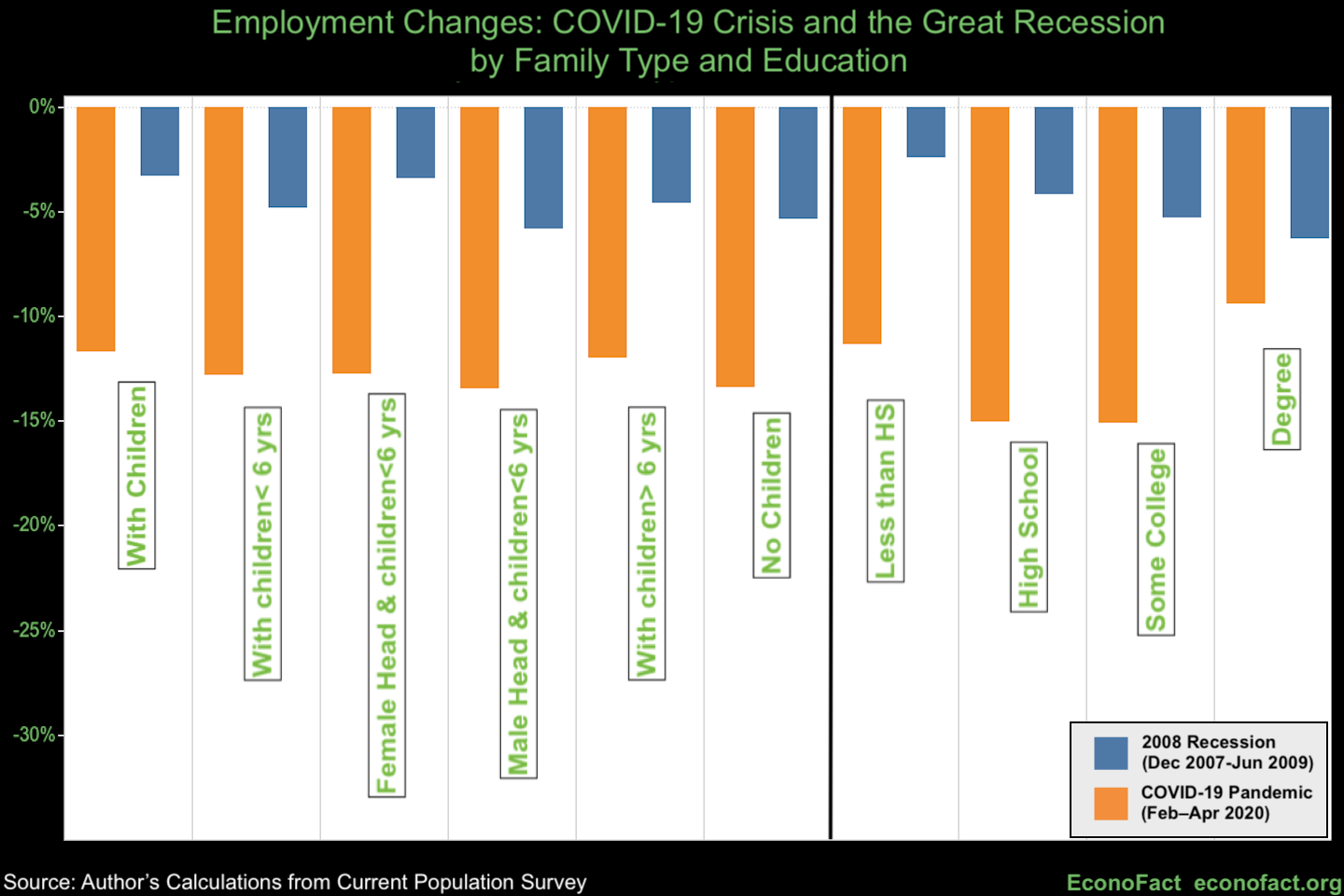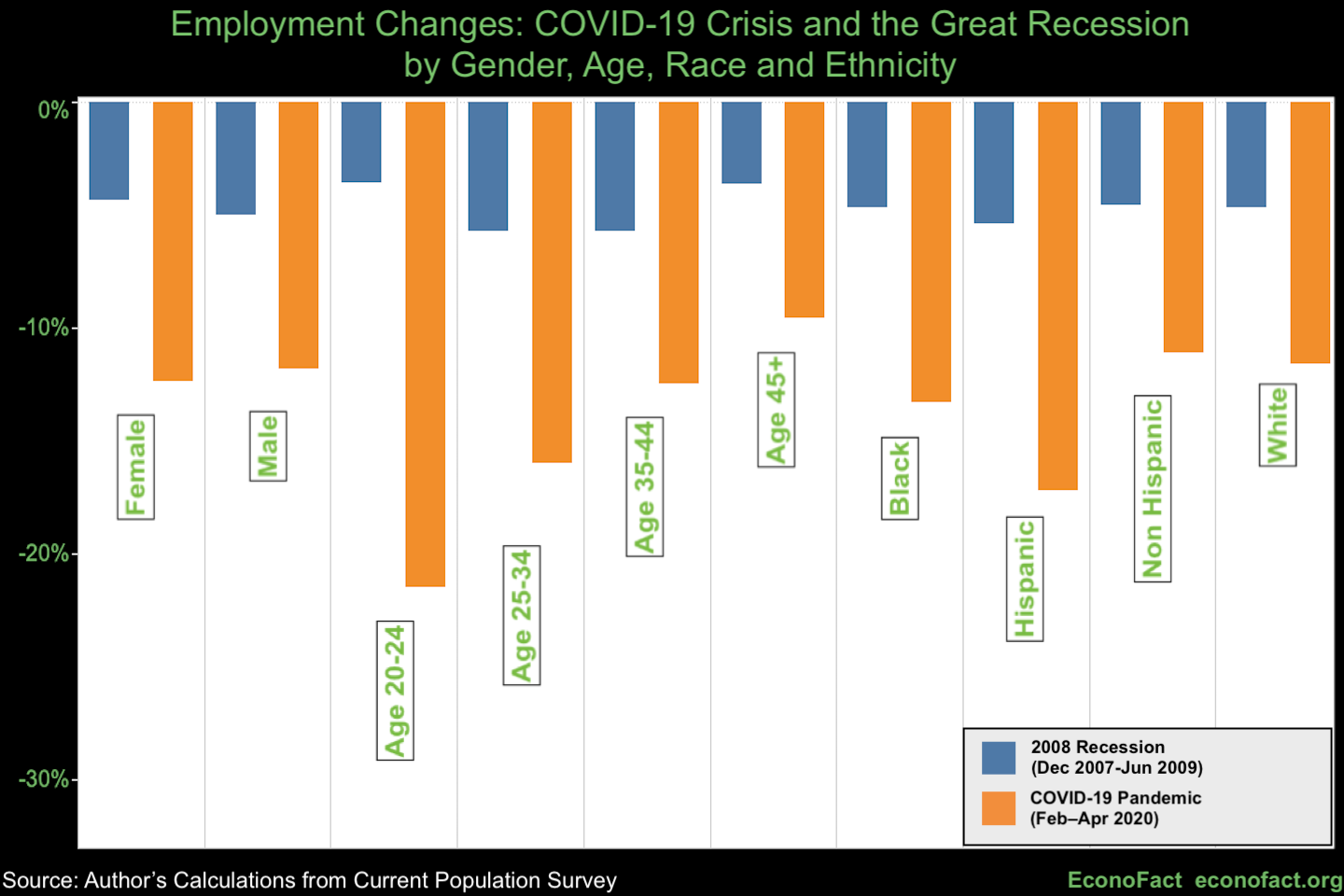Unequal Employment Impacts of COVID-19
Indiana University, Ohio State University and University of Georgia
The Issue:
The employment losses in the first two months of the COVID-19 pandemic already dwarf employment declines for the totality of the last two recessions and almost no group has been spared. However, there are large disparities in recent unemployment across different demographic groups. The largest employment declines during the COVID-19 pandemic to date are among Hispanics, younger workers and workers who have a high school degree or some college education but have not completed a college degree. In some cases these patterns differ markedly from the experience of the Great Recession that began in 2008.
Employment declines have been relatively larger for Hispanics, young people, the less educated, women, and black workers.
The Facts:
- No socioeconomic or demographic group has been spared from employment loss during the first two months of the COVID-19 pandemic, but some groups fared worse than others. In our new research, we compare employment in February 2020 to employment in April 2020 using the monthly Current Population Survey (CPS). The April CPS offers the first complete window into the employment disruptions produced by the COVID-19 pandemic, in total, as well as by state social distancing policies. We study those who are unemployed as of April 12, 2020 and had been unemployed for less than 10 weeks. We find that the job losses in the recent ten-week period were 4.5 times as high for young workers and 3.6 times as high for Hispanic workers as compared to those during the 19 months of the downturn that began in 2008 (see chart). Employment declines have also been greater for black workers than for white workers. And unlike the Great Recession, which saw greater declines in employment for men, women have seen greater declines in employment than men during this period.
- Workers in jobs in which social distancing is difficult, or in which remote work is less of an option, are more likely to face unemployment as a result of the COVID-19 pandemic and the policy responses to it. For example, social distancing is more difficult for workers in the service sector and unemployment rates are higher for some service sector occupations like food service and travel. We estimate that workers in jobs where face-to-face interactions are difficult to avoid are significantly more likely to have been unemployed during the February to April period, after taking into account other factors like gender, race, ethnicity and levels of education. In contrast, the likelihood of being unemployed is significantly lower for workers in jobs that are more compatible with remote work according to our estimates after taking into account other worker characteristics. Working in an essential industry, like healthcare, law enforcement, or food and agriculture, substantially decreases the likelihood of recent unemployment: Workers in jobs deemed essential are 67 percent less likely to have been unemployed, after taking into account other factors.
- Racial and ethnic differences in job losses due to the COVID-19 pandemic are partially explained by differences across these groups in their employment in jobs that can be done remotely. Racial and ethnic minorities are disproportionately employed in jobs with little opportunity for remote work. For example, though black workers make up about 12% of the workforce, they make up almost 20% of food preparation and serving workers. This “occupational sorting” also contributes to the fact that fewer than one in five black workers and about one in six Hispanic workers are able to work from home. In contrast, 30% of white workers and 37% of Asian workers can telework. This difference goes some way in explaining racial differences in job loss during the first two months of the COVID-19 pandemic. More than half of the gap in job loss between Hispanics and non-Hispanics, and about 40 percent of the gap in job loss between blacks and whites can be explained by the differences in occupations across these groups. These effects are somewhat mitigated by the overrepresentation of blacks and Hispanics in jobs that are deemed essential.
- Similarly, gender differences in job losses due to the COVID-19 pandemic are partially explained by differences between men and women in the types of jobs they have. Women were more likely to become unemployed between February and April, and recent unemployment rates are about 3 percentage points higher for women compared to men. Occupational sorting by gender explains some of this. The highest employment losses this year are in the hospitality and food service industries, like hotels and restaurants, which have high female employment, so the COVID-19 job crisis is hitting women particularly hard. For example, women make 77% of flight attendants, 95% of childcare workers, and 65% of restaurant wait staff according to Department of Labor statistics. The higher unemployment rates for women over the past few months contrast with experiences during past recessions that have tended to have a larger effect on male-dominated industries such as manufacturing and construction. Of the 6 million jobs lost during the Great Recession from December 2007 to June 2009, 74 percent were held by men, compared with 26 percent held by women.
- Beyond occupational sorting, part of the gender gap in employment losses and absences is potentially attributable to school closures and difficulties in finding childcare. Unemployment numbers may not cover all people who are not working because some workers are still technically employed but absent from their jobs. In our research we look at workers who are classified as “employed-but-absent” which can occur if employers released them with the intention of rehiring them, or if they are caring for dependents or a sick member of their household. There was a large increase in March of reporting employed but absent from work. Women with young children are almost 4 percent more likely to report being employed but absent from work than women without young children. Women are also far more likely to be single parents than men. These results suggest that childcare and family responsibility could play an important role in job losses if employed-but-absent is counted as unemployed, as the Bureau of Labor Statistics requires. And if absence from work indicates future unemployment, this suggests that the unemployment situation could considerably worsen. Unemployment claims may also not be showing the full extent of problems because some states are not processing them quickly enough and some groups may not be applying as much because of various perceived or real barriers. To understand the deeper meaning of these results, it is crucial to unveil the fate of those workers who are classified as employed but absent. In the following months, data will reveal whether absent workers returned to work or were subsequently laid off.

- Workers with a college degree have seen smaller employment declines relative to workers with high-school education, but some less-educated workers are protected from job loss because they are more likely to work in essential frontline industries. More highly educated workers tend to have a greater opportunity to work remotely. Graduate degree holders are about 7% less likely to have become unemployed in the 10 weeks preceding the April CPS. Overall, college graduates are about 3 percentage points less likely to be recently unemployed. At the other end of the spectrum, the group of least educated workers are relatively overrepresented in jobs that are deemed essential, such as delivery drivers and grocery store cashiers, and workers in these occupations were more likely to keep their jobs, albeit while facing a greater risk of infection. Within occupations deemed essential, the category of frontline workers is, on average, less educated, has lower wages, and has a higher representation of minorities.
What this Means:
The COVID-19 job losses are larger (after only a few months) than the total multi-year effect of the Great Recession. While working remotely or in essential jobs appear to represent shields against negative labor market outcomes during the pandemic, workers who cannot work remotely or do not have essential jobs are being pushed out of work. Our analysis suggests the costs of job loss are more concentrated among particular groups of workers, including Hispanics, young people, the less educated, women, and black workers. Not all these differentials can be explained by job or worker characteristics; future research should investigate potential other explanations including disparate treatment. These groups might need extra protection from policy makers during this unprecedented time. Efforts to support early career workers as well as older displaced workers may need to be a particular target of policy in the future. Also, strategies to improve access to childcare are needed, especially if social distancing measures and school and daycare closures are protracted. Finally, new government policies or private sector innovations that increase the viability of remote work for a larger share of the economy could be extremely valuable.
Like what you’re reading? Subscribe to EconoFact Premium for exclusive additional content, and invitations to Q&A’s with leading economists.

